
About the hand crafted instruments
At the heart of the New Music Co-op's Russolo project is the act of re-creation. Re-creating these instruments, however, presents a number of unique challenges. Though praised by composers like Ravel and Stravinski in their time, none of the original instruments or their design plans remain. Further, Russolo's descriptions of his instruments are intentionally vague because he feared design imitations. As a result, the New Music Co-op has worked from only Russolo's descriptions, the few remaining recordings, and rigorous testing to piece together its own designs for the intonarumori. Because of the project's intuitive, design-intensive nature, progress has been hard-won.
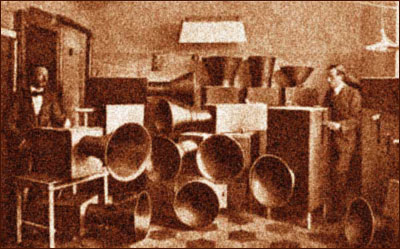
Luigi Russolo and the instruments of the Futurists circa 1916
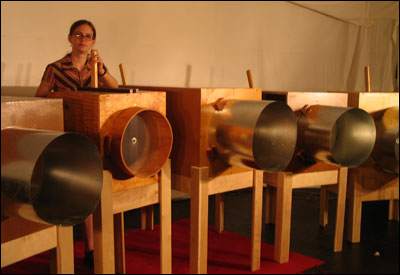
Project lead Sarah Norris and the instruments of the New Music Co-op circa 2005
The individual instruments
The following descriptions include quotes from the introduction to "Monographs in Musicology #6" by Barclay Brown (paraphrased from Russolo):
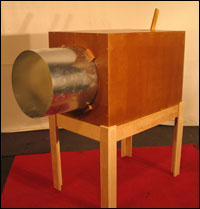 The Howler: "A noise somewhere between that of a traditional string instrument and that of a siren." Our howler features a wooden tone wheel with roughened edges. The Howler: "A noise somewhere between that of a traditional string instrument and that of a siren." Our howler features a wooden tone wheel with roughened edges.
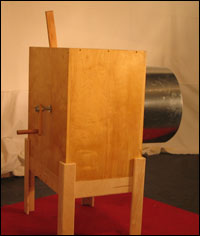 The Roarer 1: "A rumbling noise in the low-pitched instruments; not clearly described in the higher instruments." Our roarer uses a wooden tone wheel with "ridged" edges. The Roarer 1: "A rumbling noise in the low-pitched instruments; not clearly described in the higher instruments." Our roarer uses a wooden tone wheel with "ridged" edges.
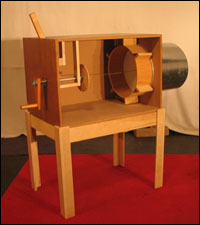 The Crackler: "A metallic crackling noise in the high-pitched instruments; a strident metallic clashing in the lower ones." The crackler calls for a metal wheel. Instead, we used a wooden wheel with a length of metal chain attached around its edge. The Crackler: "A metallic crackling noise in the high-pitched instruments; a strident metallic clashing in the lower ones." The crackler calls for a metal wheel. Instead, we used a wooden wheel with a length of metal chain attached around its edge.
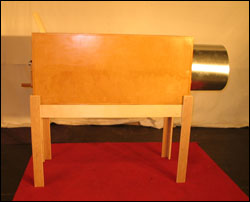 The Scraper: "A metallic scraping or rubbing sound, less forceful than the sound of the preceding instruments." The scraper calls for a metal tone wheel, but we found that a metal wheel tends to cut the string over time. As a substitute, we used a wooden wheel and applied metal edging. The Scraper: "A metallic scraping or rubbing sound, less forceful than the sound of the preceding instruments." The scraper calls for a metal tone wheel, but we found that a metal wheel tends to cut the string over time. As a substitute, we used a wooden wheel and applied metal edging.
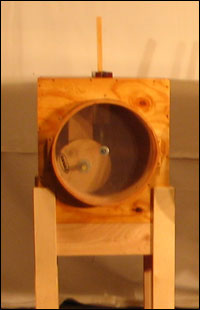 The Roarer 2: "A rumbling noise in the low-pitched instruments; not clearly described in the higher instruments." Our roarer uses a wooden tone wheel with "ridged" edges. The Roarer 2: "A rumbling noise in the low-pitched instruments; not clearly described in the higher instruments." Our roarer uses a wooden tone wheel with "ridged" edges.
Design and Construction of the Instruments
Design and construction of the New Music Co-op's intonarumori began over two years ago. The project is entirely volunteer-based, and our brainstorming and building sessions have occurred everywhere from living rooms to front porches to garages to, finally, a real woodworking shop. Materials are a mixture of store-bought hardware, recycled carpentry supplies, and cast-off musical gear. When friends changed drum heads or bass strings, the intonarumori got the hand-me-downs.
Our first prototype was based on a small wooden box salvaged from a deconstructed pipe organ. Though the affectionately named "little guy" has become something of a mascot for our project, its size restricted it from becoming fully functional, and it revealed to us our minimum dimensional requirements. This set us on the path of ever-bigger instruments, often limited only by the cabinet materials we currently had at our disposal.
As we worked, we made a number of design modifications. Between the second and third instruments, we switched from using plywood to MDF, a composite material. MDF's regular consistency enhances its resonant qualities. We also devised several methods for securing turning parts that inevitably unscrew themselves in unintended directions. These methods included mounting stabilizing pegs and washers at key points inside the instruments. Further, as we perfected our abilities to create tone wheels of reliable dimensions, we experimented with our tone wheel options, eventually settling on thin wheels to avoid dampening the string's vibrations. Interesting wheel variants included the "dance party wheel" (with a protruding nail which created a novel beat) and the "shark wheel" (with fin-like protrusions around its edge.)
 The basic design of the intonarumori is relatively simple. Each instrument is a wooden box with a drum head and a metal bell mounted on its front. A string is threaded through the center of the drum head and into the box, where it attaches to a pitch lever that the performer adjusts from the top of the instrument. A tone wheel turns against the string to produce the instrument's sound. The wheel's material and its surface determine the exact type of instrument (howler, roarer, etc.). The performer turns the tone wheel with a crank arm on the back of the cabinet. The combination of the tone wheel and pitch lever encompasses the two basic goals of Russolo's design: that the instrument produce raucous, environmental noises (the tone wheel) that are musically harnessed into variable, controllable pitch (the pitch lever). The basic design of the intonarumori is relatively simple. Each instrument is a wooden box with a drum head and a metal bell mounted on its front. A string is threaded through the center of the drum head and into the box, where it attaches to a pitch lever that the performer adjusts from the top of the instrument. A tone wheel turns against the string to produce the instrument's sound. The wheel's material and its surface determine the exact type of instrument (howler, roarer, etc.). The performer turns the tone wheel with a crank arm on the back of the cabinet. The combination of the tone wheel and pitch lever encompasses the two basic goals of Russolo's design: that the instrument produce raucous, environmental noises (the tone wheel) that are musically harnessed into variable, controllable pitch (the pitch lever).
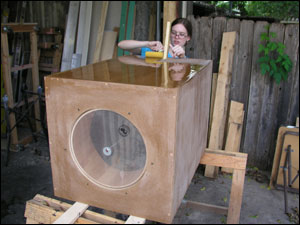 Our intonarumori may be tuned at both the drum head and the string. Tone wheels are designed to be interchangeable between the instruments, and drum heads may be changed if necessary. Because the design process was an act of learning and discovery, the exact materials and design specifications vary from instrument to instrument. Thus, the succession of instruments documents the successive stages of our design process. Our intonarumori may be tuned at both the drum head and the string. Tone wheels are designed to be interchangeable between the instruments, and drum heads may be changed if necessary. Because the design process was an act of learning and discovery, the exact materials and design specifications vary from instrument to instrument. Thus, the succession of instruments documents the successive stages of our design process.
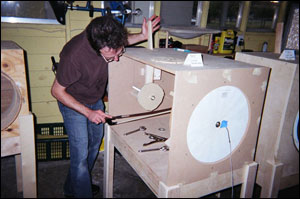 Russolo originally created 12 categories of intonarumori which grew progressively more complex. Instruments like the gurgler, hisser, burster, and croaker may have included vibrating springs, electric motors, telescoping pipes, and even a mechanical bellows. Though the basic box design of all the intonarumori was the same, the functional details of these later instruments are not clearly understood. For this reason, we chose to focus our work on the first four instruments of Russolo's series, the howler, roarer, scraper, and crackler. Russolo originally created 12 categories of intonarumori which grew progressively more complex. Instruments like the gurgler, hisser, burster, and croaker may have included vibrating springs, electric motors, telescoping pipes, and even a mechanical bellows. Though the basic box design of all the intonarumori was the same, the functional details of these later instruments are not clearly understood. For this reason, we chose to focus our work on the first four instruments of Russolo's series, the howler, roarer, scraper, and crackler.
|

